The Best Charcoal Starters
Published On: 5/16/2019 Last Modified: 6/16/2025

Click Here To Search Our Reviews And Ratings Of Tools, Toys, And Accessories
There are many ways to light charcoal, but we think there is one wrong way.
Please don’t use starter fluid, mineral spirits, gasoline, kerosene, or any hydrocarbons. They soak into the coals and emit a stink that I can smell from blocks away. When I smell it I want to march over to my neighbor with a fire extinguisher and a link to this page. Petroleum solvents soak into charcoal and can continue burning while food is over them. They can flavor the food.
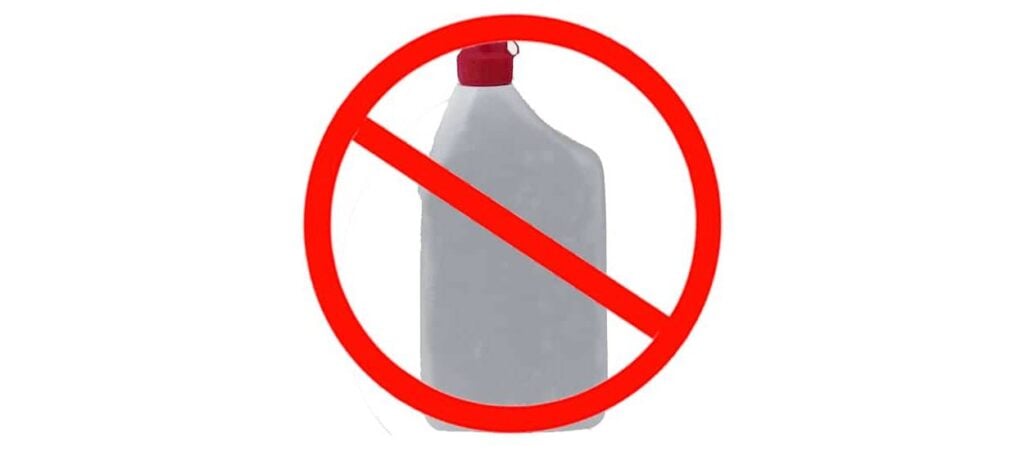
Gas and kerosene put out noxious vapors. Here’s a news video about a man who died from gasoline fumes used to ignite a charcoal fire. Let’s not talk about how many sleeves have caught fire while trying to light coals with fluid and a cigarette lighter, and if your fire doesn’t get off to a roaring start please please please don’t squirt it with starter fluid unless you’ve been wanting to see how the inside of the hospital’s burn unit looks.
And stay away from the easy lighting charcoal. Just open the bag and smell. They are soaked in mineral spirits. All the way to the core. So petroleum products are in the smoke right to the end. And you can taste it in the food. I prefer salt and pepper thank you.
Here are some techniques that work. Remember that there are really two fuels, charcoal and oxygen, so make sure all the vents are open wide when you try to light the coals. With briquets you should wait until the heavy smoke subsides a bit and the coals are covered in white ash before you start cooking. Lump will not ash over, so about 15 minutes is sufficient.
The best way: The charcoal chimney
When working with charcoal controlling temperature is tricky. The more charcoal, the hotter the fire. So it is important to measure how much charcoal you are using. There are about 16 Kingsford briquets in a quart, so a gallon is about 64 briquets. That is a fixed quantity of energy capable of generating known quantity of heat. With practice you learn how many more to add on cold days, and how many fewer on hot days.
We think charcoal chimneys such as the Weber Rapidfire Chimney Starter are the best way to start a charcoal fire. A chimney is a tube with an upper compartment and a lower compartment. First you stuff newspaper into the bottom compartment, add charcoal to the top compartment, then you light the paper, and after about five minutes, put on a glove and grab the handle and give a shake so the unlit coals on top will turn over and that’s about it.
In about 15 minutes the coals are white and ready. The hot air from the newspapers rises and sucks oxygen in through the bottom which ignites the coals and creates an updraft that grows rapidly in heat making the top of the chimney blowtorch hot.
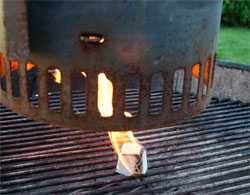
Some folks have been known to drizzle some cooking oil on the newspaper to make it burn longer but I’ve never found this necessary. Another technique is to use firestarters on the chimney. Weber sells small cubes of paraffin that work just fine (above). The package says to use two per chimney, but one is really all you need. You can even make your own starter cubes.
Many folks put their chimney on the sideburner of a gas grill, where you can light the chimney in a hurry.
With a chimney there is no chemical aftertaste, no solvent smell in the air, and it’s a lot cheaper and safer than using lighter fluid. Just make sure you place it on something heatproof after you dump out the coals, and away from children and pets.
Another feature of the chimney is that it is an excellent temperature controller for your cooking because it is a measuring cup! As you get experienced, you will learn just how high to fill the chimney in order to get your grill to the desired temp.
There is something else cool about the chimney. You can cook on it! It makes a better wok fire than anything in your kitchen. Just sit your wok on top and stir fry away. Incredibly hot. Or you can put a grate on it and cook thin foods right on top of the chimney, a technique I call the Afterburner Method.
Make your own fire starter cubes
Starter cubes with a chimney are our favorite way to start charcoal. Here’s how to make your own. They will burn for at least 5 minutes, long enough to start a chimney.
Supplies
Paraffin wax blocks or some left over wax from used candles
Newspaper, cotton balls, or some dryer lint (whatever you have handy)
Method
1) Put the parafin in a disposable aluminum pan, place the pan over a low heat source and melt the wax completely.
2) If you are using newspaper tear the pages into squares about 12″ x 12″, crumple into balls, and dip them into the wax holding one corner so it can act as the fuse when you light it. If you are using cotton balls simply hold a corner and dip into the melted wax. If you are using drier lint, make a ball about the size of a golf ball and dip.
3) Break open a cardboard box and lay it flat. Cover it with foil or parchment paper. Put the wax dipped starters on the foil and let them dry. Once the wax has had time to harden use a scrapper or spatula to break them free. Bag or box the cubes and store them in a cool area, away from direct sunlight or moisture.
To use the starters simply fill your chimney with charcoal place the starter on your grill grates and light one corner. Place the chimney over the lit starter and the coals will catch.
For long cooks
Part of the problem with charcoal is that it starts cold, heats up rapidly, hits a peak, and then slowly cools as the fuel is consumed.
But it is important to keep the temp of your grill or smoker constant. There are several clever solutions. The core concept of them all is that you put lit coals on top of unlit coals, or visa versa, or side by side, and the ignition of the new coals synchronizes with the death of old coals.
They work well with one noteworthy problem. Freshly lit coals put out a lot of smoke, and it is thick white smoke, not the thin blue smoke that makes the best flavor.
The Minion Method
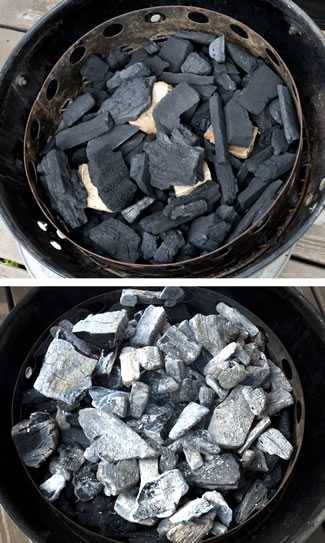
The Minion Method came first. Named after Jim Minion, a caterer who invented the technique, you start by pouring a Weber chimney full of unlit coals (80 briquets) into the grill or smoker and bury about three chunks of wood in the pile. Then put 1/2 a Weber chimney (40 briquets) of hot coals on top of cold coals, and a lump of wood on top. The exact number of coals will vary depending on the brand you use, the smoker, and the weather. It is the standard technique now for the very popular Weber Smokey Mountain bullet smoker.
The fuse method
To light the fuse, known as the snake, C, or U method, you put the coals in a C or U shape, ignite one end, and walk away. It works remarkably well. Here is how it looks on a Weber Kettle or a bullet smoker.
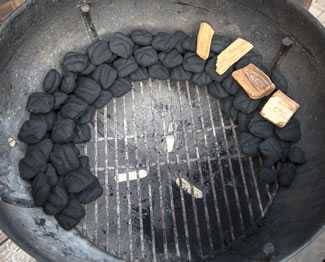
Here is how it looks on a Backwoods Smoker, but it can be adapted to many others.

As you can see that I have divided the coal tray with two bricks. No special firebricks, just bricks. The coals are spread out around the U and there is wood scattered along the path. Hot coals lit in a chimney are poured in one end on top of a wood chunk and the door is closed.

After about three hours. Notice the second chunk of wood has begun to smolder.
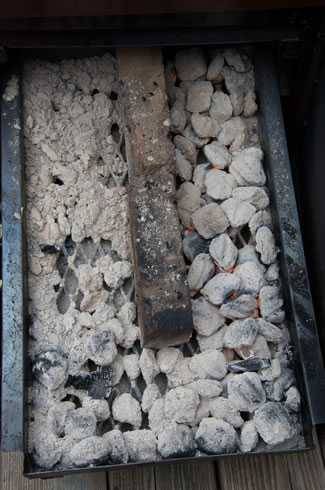
After six hours.
Low tech methods
Place a dozen briquets in a cardboard egg carton and pile more on top. Light the carton (an “eggcellent” option if you live on a chicken farm!). Or you can take a wad of newspapers or paper napkins and put them on your charcoal grate, drizzle cooking oil on them, and cover them and surround them with coals. The AmazingRibs.com science advisor Prof. Greg Blonder adds “Be aware that sometimes glowing newspaper ash can blow out of the grill. If it is located near combustible plantings [I think this is scientific speak for overhanging tree branches], make sure the flying newspaper embers don’t set the neighborhood ablaze.” Hmmmmm. Sounds like the voice of experience…
Discard the dust
Often there is charcoal dust and small crumbs in the bottom of the bag. Discard them. If you pour them in your grill they can clog the airspaces between the coals and constrict airflow and choke back your fire by as much as 50°F. Remember, oxygen is just as important as charcoal!
Discard the ashes
Empty the bottom of your grill. Ash is a great insulator and it reduces the amount of heat bouncing off the bottom of the cooker. On the other hand it reduces the amount of heat escaping through the bottom of the cooker. But too much ash can choke off oxygen, or be stirred up and coat your food with gray dust.
Stopping charcoal fires
I prefer to suffocate the fire by closing all vents. It can take an hour or more for the coals to die, but they will die if your cooker is reasonably tight. You can extinguish a charcoal fire by dousing it with water, but beware, steam that that can peel the skin off your face will come up in a hurry, and the hot water that will pour out of the bottom of your grill can put you in a wheel chair for a while.
Also, wet ashes can form a concrete-like crust that can corrode your grill. When they are thoroughly dry, coals can then be shaken to slough off the ash, and used again. But it can take days for them to get thoroughly dry so if you plan to use the grill soon, don’t douse the coals with water. If you have a ceramic grill, never use water to douse the fire or it might crack.
A video about charcoal
Here’s a video about the different types of charcoal, their pros and cons, and why we recommend briquets. Watch the video to see why. Also there’s a discussion of wood types, and how to set up a grill in the essential 2-zone system. Click here for more on the science of charcoal and more on the science of smoke and wood.
HomeRight Charcoal Starter Lights Coals Fast
The HomeRight ElectroLight Fire Starter gets your charcoal, fireplace, or wood stove ignited quickly. Click to read our full review.Charcoal Starters: The Looftlighter Review
A cross between a hair dryer and a flamethrower, the Looftlighter is electric and requires an outlet. Read our review to learn more.Charcoal Starters: The Electric Starter
The electric charcoal starter features a coil similar to ones on a hotplate. Pour a pile of charcoal in your grill and jam the coil into it.Charcoal Starters: Propane Torch, AKA The Weed Burner
There are ordinary starters and then there's the Red Dragon flame thrower. Connect it to a propane tank, hit the spark, and whoosh!BBQ Dragon Spin Grate Makes Charcoal Grilling Easier
The BBQ Dragon Spin Grate rotates 360 degrees, making cooking on round kettle grills much simpler. Read our full review.Related articles
- Ratings And Reviews Of Hundreds Of Grills, Smokers, Hog Roasters, And More (8 Pages, 19 Articles)
- BBQ And Kitchen Tools, Toys, And Accessories Rated And Reviewed (23 Pages)
- The GrillBox 2.0 Review And Rating


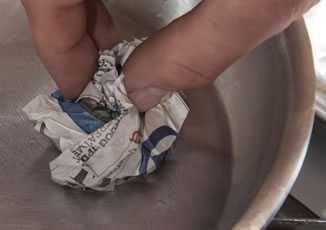
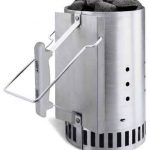
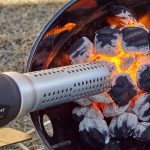
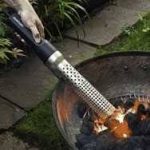
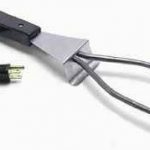

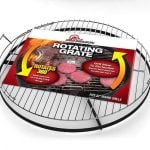

High quality websites are expensive to run. If you help us, we’ll pay you back bigtime with an ad-free experience and a lot of freebies!
Millions come to AmazingRibs.com every month for high quality tested recipes, tips on technique, science, mythbusting, product reviews, and inspiration. But it is expensive to run a website with more than 2,000 pages and we don’t have a big corporate partner to subsidize us.
Our most important source of sustenance is people who join our Pitmaster Club. But please don’t think of it as a donation. Members get MANY great benefits. We block all third-party ads, we give members free ebooks, magazines, interviews, webinars, more recipes, a monthly sweepstakes with prizes worth up to $2,000, discounts on products, and best of all a community of like-minded cooks free of flame wars. Click below to see all the benefits, take a free 30 day trial, and help keep this site alive.
Post comments and questions below
1) Please try the search box at the top of every page before you ask for help.
2) Try to post your question to the appropriate page.
3) Tell us everything we need to know to help such as the type of cooker and thermometer. Dial thermometers are often off by as much as 50°F so if you are not using a good digital thermometer we probably can’t help you with time and temp questions. Please read this article about thermometers.
4) If you are a member of the Pitmaster Club, your comments login is probably different.
5) Posts with links in them may not appear immediately.
Moderators